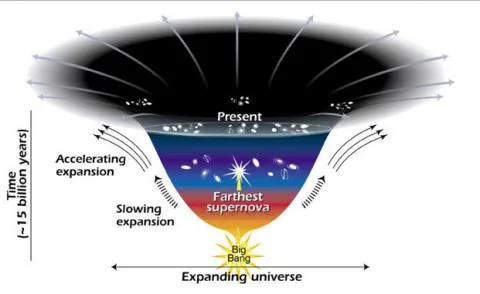3-D Map of the Universe | 15 Apr 2024
For Prelims: Dark Energy, space Technology, lunar mission, Radio Telescopes, optical telescope, ISRO, NASA, ESA, TIFR, DESI
For Mains: Discuss the type and nature of Dark Energy.
Why in News?
Recently, the most comprehensive three-dimensional map of the universe has been released by an international team of researchers.
- Scientists believe that this development could reveal some clues about Dark Energy.
- This map, derived from the first year of observations by the Dark Energy Spectroscopic Instrument (DESI), offers insights into the spatial distribution of galaxies and holds promise in unravelling the mysteries of Dark Energy.
What are the Universe's Fundamental Components?
- The universe is made up of three components:
- Normal or visible matter (5%)
- Dark matter (27%),
- Dark energy (68%)
- Normal Matter:
- Normal matter makes up everything we can directly observe.
- It is composed of atomic particles like protons, neutrons, and electrons.
- It can exist as gas, solid, liquid, or plasma of charged particles.
- Dark Matter:
- Like ordinary matter, dark matter takes up space and holds mass.
- Dark matter is invisible and does not interact with light, making it impossible to directly observe.
- It exerts gravitational influence, as evidenced by its impact on the motion of stars, gas, and galaxies.
- Dark matter is believed to form halos around galaxies, and it is more prevalent in dwarf galaxies compared to larger ones.
- Dark Energy:
- Dark energy is a mysterious force that counteracts gravity, causing the expansion of the universe to accelerate.
- Despite being invisible like dark matter, dark energy has a different effect, pushing galaxies apart instead of pulling them together.
- The discovery of dark energy in 1998 was based on measurements of cosmic expansion, which revealed an increasing rate of expansion.
- Nature of Dark Energy:
- The recent findings have raised the tantalising possibility that dark energy – a mysterious, repulsive force that drives the process – is not constant throughout time as has previously been suggested.
- Dark Energy is detected by its effect on the rate at which the universe expands and its effect on the rate at which large-scale structures such as galaxies and clusters of galaxies form through gravitational instabilities.
Dark Energy Spectroscopic Instrument (DESI):
- DESI is a unique piece of equipment that, once fitted over a telescope, can capture light from 5,000 galaxies at the same time.
- It is a collaboration of more than 900 researchers in institutions across the world. From India, TIFR (Tata Institute of Fundamental Research) is the only participating institution.
- Using DESI, which is mounted over the Mayall 4-Meter Telescope in Arizona, US, researchers have been able to measure light from six million galaxies — some of which existed as far back as 11 billion years ago.
- This was used to prepare the most detailed map of the universe as yet.
Read more: Dark Energy, Dark Matter
UPSC Civil Services Examinations, Previous Year Questions
Q.1 Which of the following is/are cited by the scientists as evidence/evidence for the continued expansion of the universe? (2012)
- Detection of microwaves in space
- Observation of redshift phenomenon in space
- Movement of asteroids in space
- Occurrence of supernova explosions in space
Select the correct answer using the codes given below:
(a) 1 and 2
(b) 2 only
(c) 1, 3 and 4
(d) None of the above
Ans: (a)
Q.2. In the year 2008, which one of the following conducted a complex scientific experiment in which sub-atomic particles were accelerated to nearly the speed of light? (2008)
(a) European Space Agency
(b) European Organization for Nuclear Research
(c) International Atomic Energy Agency
(d) National Aeronautics and Space Administration
Ans: b

